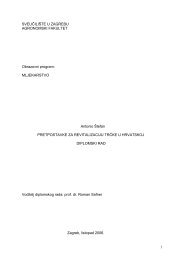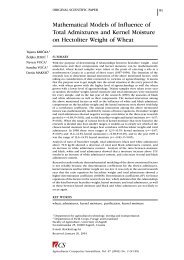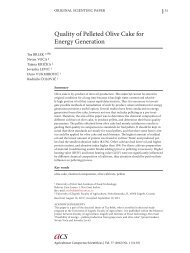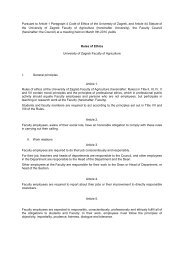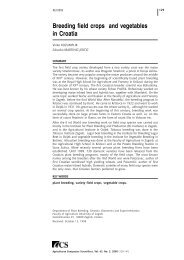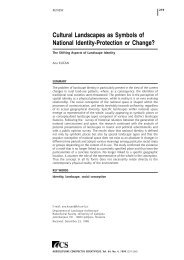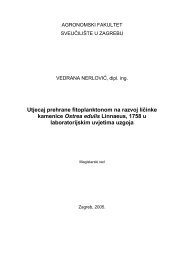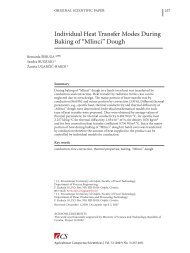Production of Fig (Ficus carica L.) Nursery Plants by Stem Layering ...
Production of Fig (Ficus carica L.) Nursery Plants by Stem Layering ...
Production of Fig (Ficus carica L.) Nursery Plants by Stem Layering ...
Create successful ePaper yourself
Turn your PDF publications into a flip-book with our unique Google optimized e-Paper software.
ORIGINAL SCIENTIFIC PAPER<br />
157<br />
<strong>Production</strong> <strong>of</strong> <strong>Fig</strong> (<strong>Ficus</strong> <strong>carica</strong> L.)<br />
<strong>Nursery</strong> <strong>Plants</strong> <strong>by</strong> <strong>Stem</strong> <strong>Layering</strong><br />
Method<br />
Oguz DOLGUN 1( )<br />
Faik Ekmel TEKINTAS 2<br />
Summary<br />
This research was carried out in Turkey in 2006. The aim <strong>of</strong> the present<br />
research is to study the possibility <strong>of</strong> fig nursery plant production with stool<br />
bed layering method. <strong>Fig</strong> cultivar Sarilop was used as a material. It is the best<br />
fig cultivar for drying and it can also be consumed fresh. The mother plants<br />
were planted horizontally with distance <strong>of</strong> 70 x 60 cm in November after the fall<br />
<strong>of</strong> the leaves. In February, all the buds on the ground side <strong>of</strong> plants were blunted<br />
and plants were fixed parallel (layered) to the ground surface with prongs made<br />
<strong>of</strong> a thick galvanized wire in the shape <strong>of</strong> U. Bottom parts <strong>of</strong> the new shoots<br />
which developed from the mother plants and reached 20 cm were covered <strong>by</strong> 10<br />
cm <strong>of</strong> soil. Bottom parts <strong>of</strong> the newly formed shoots were continuously covered<br />
with the soil taken from between the rows appropriately to the development <strong>of</strong><br />
the shoots during vegetation period. At the end <strong>of</strong> the vegetation period, eighty<br />
nursery plants <strong>of</strong> different sizes were obtained from twenty mother plants. Most<br />
<strong>of</strong> the nursery plants (77.5 %) had sufficient qualitative and quantitative features<br />
for sale. The small sized plants, which may not be sold, can be used as nursery<br />
plant or mother plant (stock) after one year <strong>of</strong> care period. It was determined<br />
in this research that it was possible to propagate nursery plant <strong>by</strong> stem layering.<br />
The production <strong>of</strong> fig nursery plants <strong>by</strong> stem layering with low production costs<br />
is suggested to as an alternative method for the production <strong>of</strong> fig nursery plants.<br />
Key words<br />
fig, propagation, layering, nursery plant, “Sarılop”<br />
1 Adnan Menderes University, Sultanhisar Vocational College, Sultanhisar, Aydin, Turkey<br />
e-mail: odolgun@adu.edu.tr<br />
2 Adnan Menderes University, Faculty <strong>of</strong> Agriculture, Department <strong>of</strong> Horticulture,<br />
Kocarli, Aydin,Turkey<br />
Received: March 27, 2007 | Accepted: June 4, 2008<br />
Agriculturae Conspectus Scientificus | Vol. 73 (2008) No. 3 (157-160)
158 Oguz DOLGUN,, Faik Ekmel TEKINTAS<br />
Introduction<br />
<strong>Fig</strong> is a subtropical fruit that belongs to the <strong>Ficus</strong> genus<br />
<strong>of</strong> the Moraceae family. It is grown in some parts <strong>of</strong> the<br />
world such as Mediterranean region, South West Asia,<br />
South America, South Africa, Caucasia and in a lesser<br />
extent in Australia. <strong>Fig</strong> fruits, having quite large nutritional<br />
values, are consumed fresh or dried and it is accepted as a<br />
blessed fruit in celestial religions. Due to these specifications,<br />
it has been cultivated and consumed since ancient<br />
times (Kabasakal, 1990; Aksoy and Can, 1993; Botti et al.,<br />
1997; Pareira and Nachtigol, 1997; Yildiz,1999).<br />
<strong>Fig</strong> nursery plants can be produced with different production<br />
methods such as layering, bottom shoots and tip<br />
cuttings (Aksoy, 1990). With production <strong>of</strong> classical layering<br />
and bottom shoots methods, small amount <strong>of</strong> nursery<br />
plants are produced because <strong>of</strong> the limited shoots. For<br />
this reason, these methods are not prefered in commercial<br />
nursery plant production. Therefore, in commercial<br />
nursery plant production figs are propagated <strong>by</strong> tip cuttings<br />
in field or misted rooting units (Dolgun et al., 2003;<br />
Kabasakal, 1990).<br />
In field production, ecological conditions such as sudden<br />
changes <strong>of</strong> temperature and low moisture adversely affect<br />
rooting and growing <strong>of</strong> cuttings. It is important to prepare<br />
the soil and seize a suitable climate conditions in order to<br />
use this method for production. Even the slightest stress<br />
conditions, faced during production can adversely affect<br />
production costs and quantity.<br />
<strong>Fig</strong> cuttings can easily be rooted bottom heated and<br />
fogged rooting units. They show a high rate <strong>of</strong> rooting in<br />
bottom heated and misted rooting units but these roots<br />
are rather brittle. While transferring into the ground or a<br />
tube, these fragile roots are damaged and the plants which<br />
have such roots wilt and die in a short time. Although it<br />
is supposed that it is easy to produce fig nursery plants <strong>by</strong><br />
cuttings, since they have a high rooting ability, the desired<br />
level <strong>of</strong> success and continuity can not be achieved because<br />
<strong>of</strong> these problems. The aim <strong>of</strong> the present research is to<br />
solve problems faced in the production <strong>of</strong> fig nursery plants<br />
and to study the possibility <strong>of</strong> fig nursery plant production<br />
with stool bed layering method. Recently, stool bed<br />
layering method was intensively used during propagation<br />
<strong>of</strong> many different fruit crops including some dwarf apples,<br />
from which cuttings can hardly be rooted. (Boutherin and<br />
Brong, 1989; Sadhu, 1989; Hartmann et al., 1990; Kembelo,<br />
1992; Seferoglu et al., 1994; Nicholas, 1998; Shaltout et al.,<br />
1998; Dolgun et al., 2003; Cobanoglu et al., 2004).<br />
Materials and methods<br />
In this research, nursery plants <strong>of</strong> fig cultivar Sarilop<br />
for drying were used as a plant material. “Sarilop” is the<br />
best fig cultivar for drying in the world. It has big and<br />
light yellow coloured fruits with a high level <strong>of</strong> sugar. The<br />
fruits can also be consumed fresh, and they are exported<br />
to other countries <strong>of</strong> the world both dried and fresh.<br />
The trees are 7-8 m in height and have a wide and shallow<br />
form. <strong>Fig</strong> can be cultivated in different soil and drought<br />
conditions. It has got a dioic flower structure. (Eroğlu,1976;<br />
Anonymous, 2001; Aksoy, 1993). In this research one-year<br />
old tube mother plants with average height <strong>of</strong> 60 cm and<br />
trunk diameter 1.7 cm measured at a distance <strong>of</strong> 5 cm from<br />
the soil surface were used. The bottom and middle parts<br />
<strong>of</strong> the mother plants were well lignified. The tip parts were<br />
semi-lignified. On average, each plant had 18 buds.<br />
The place for nursery is ploughed deeply and 1 m 3 <strong>of</strong><br />
eliminated manure were added to every 10 m 2 plot and<br />
mixed in depth <strong>of</strong> 30-40 cm <strong>of</strong> the soil. After that, soil surface<br />
was hoed and raked. The mother plants were planted<br />
horizontally with distance <strong>of</strong> 70 x 60 cm in November<br />
after the fall <strong>of</strong> the leaves. In February, all buds on the<br />
ground side <strong>of</strong> the plants were blunted with a sharp knife<br />
and then the mother plants were fixed parallel (layered)<br />
to the ground surface with prongs made <strong>of</strong> a thick galvanized<br />
wire in the shape <strong>of</strong> U. <strong>Nursery</strong> was designed as a<br />
randomized split plots with four replicates, and five plants<br />
were used for each replicate.<br />
The first covering with the soil was carried out when<br />
the new shoots which developed from the layered (mother)<br />
plants reached 20 cm. Bottom 10 cm <strong>of</strong> shoots were covered<br />
with soil and were continuously covered with the soil taken<br />
between the rows appropriately to the development <strong>of</strong> the<br />
shoots. <strong>Plants</strong> were watered <strong>by</strong> sprinkles in order to keep<br />
the soil moisture. Special attention was paid at keeping the<br />
soil moisture so that the parts remaining in the soil root<br />
efficiently. No chemicals were used in this research.<br />
At the end <strong>of</strong> the vegetation period, the soil put on the<br />
bottom parts <strong>of</strong> the new plants formed from shoots was<br />
carefully taken away and rooted plants, which developed<br />
during the vegetation period, were cut <strong>of</strong>f from mother<br />
plants. Total number <strong>of</strong> plants was counted and the number<br />
<strong>of</strong> plants which developed from the buds <strong>of</strong> the bottom,<br />
middle and tip buds was determined separately. The number<br />
<strong>of</strong> roots more than 2 mm thickness, the height, stem diameter,<br />
fresh and dry weight <strong>of</strong> the plants were determined.<br />
Buds and roots <strong>of</strong> each plants were counted manually. Band<br />
measuring device was used for the height measurements<br />
<strong>of</strong> each nursery plant. <strong>Stem</strong> diameter was measured with<br />
electronic caliper. <strong>Stem</strong> fresh and dry weights were determined<br />
with the scales with sensitivity <strong>of</strong> 0.01 g (Scaltec<br />
Instruments, Heilingenstad, Germany).<br />
Results and discussion<br />
At the end <strong>of</strong> the research, 80 plants <strong>of</strong> different size<br />
were obtained from 20 mother plants. An average <strong>of</strong> four<br />
Agric. conspec. sci. Vol. 73 (2008) No. 3
<strong>Production</strong> <strong>of</strong> <strong>Fig</strong> (<strong>Ficus</strong> <strong>carica</strong> L.) <strong>Nursery</strong> <strong>Plants</strong> <strong>by</strong> <strong>Stem</strong> <strong>Layering</strong> Method<br />
159<br />
Table 1. Quantities <strong>of</strong> obtained plants <strong>of</strong> different sizes<br />
Plant Length (cm)<br />
10-20 21-30 31-40 41-50 51-60 61-70 71-80 81and up<br />
Number 5 9 4 8 7 7 2 38<br />
Table 2. Average <strong>of</strong> examined characteristics<br />
Plant Length <strong>Stem</strong> Diameter Bud Number Root Number <strong>Stem</strong> Dry Weight <strong>Stem</strong> Fresh Weight<br />
Lowest Buds 102.10a 22.21a 23.95a 11.08a 85.18a 196.85a<br />
Middle Buds 54.45b 14.72b 13.95b 8.20b 26.60b 55.45b<br />
Tip Buds 26.85c 11.52c 9.92c 6.68c 14.50b 35.17b<br />
LSD 0.05 7.301 2.552 2.915 1.175 17.472 35.527<br />
nursery plants obtained from each mother plants which<br />
have an average <strong>of</strong> nine buds after blunting. The numbers<br />
<strong>of</strong> the plants grouped with sizes <strong>of</strong> 10 cm increment were<br />
shown in the Table 1.<br />
A total <strong>of</strong> 62 plants higher than 40 cm, which can be<br />
used for establishing <strong>of</strong> orchards, were accepted as nursery<br />
plants for sale (77.5 %).<br />
The findings were evaluated statistically using SAS<br />
(1996). Plant length, stem diameter, bud number, root<br />
number, stem dry and fresh weight <strong>of</strong> the nursery plants<br />
were found to be significantly different.<br />
Statistic values concerning the nursery plants formed<br />
from the bottom, middle and tip buds are given in Table<br />
2.<br />
<strong>Nursery</strong> plants which formed from the bottom buds<br />
had the highest value for plant length (102.10a). Bottom<br />
bud plants have a significant superiority to middle (54.45b)<br />
and tip (26.85c) bud plants for plant length. Bud number is<br />
significantly higher in bottom bud plants (23.95a). Middle<br />
(13.95b) and tip (9.92c) bud plants have lower values for bud<br />
number. For stem diameters, bottom bud plants have high<br />
value (22.21a). Middle (14.72b) and tip (11.52c) bud plants<br />
have low statistical values for stem diameters. Bottom bud<br />
plants have significantly highest statistical value (85.18a)<br />
for stem dry weights. Middle (26.60b) and tip (14.50b)<br />
buds have lower values. For stem fresh weights, bottom<br />
bud plants have highest statistical value (196.85a). Bottom<br />
bud plants have a superiority to middle (55.45b) and tip<br />
(35.17b) bud plants for stem fresh weights.<br />
The literature on propagation <strong>of</strong> figs <strong>by</strong> layering method<br />
is very limited. There is some literature on propagation<br />
<strong>of</strong> figs <strong>by</strong> cuttings. Yildiz (1999) studied different propagation<br />
methods <strong>by</strong> cuttings for increase production <strong>of</strong><br />
nursery plants <strong>of</strong> “Bursa Siyahı” fig cultivar and obtained<br />
nursery plants which had an average stem height <strong>of</strong> 15.06<br />
cm. They also determined that stem fresh and dry weights<br />
were 22.06 g. and 9.88 g. respectively.<br />
By cutting <strong>of</strong> “Sarılop” and “Bursa Siyahı” fig cultivars<br />
and using chemicals Dolgun et al. (2003) obtained nursery<br />
plants with average height <strong>of</strong> 108 cm, average stem diameter<br />
<strong>of</strong> 1.91 cm, average fresh weight <strong>of</strong> 251.51 g and average<br />
dry weight <strong>of</strong> 138.58 g.<br />
It is not possible to compare these two studies that were<br />
carried out on rooting <strong>of</strong> the cuttings with the results <strong>of</strong><br />
the this research.<br />
It is well known that fig is a plant with a single branching<br />
out (monopodial) and it has a strong apical dominancy.<br />
It forms strong shoots from apical (tip) buds. But in<br />
this research, it was observed that plants from the tip buds<br />
<strong>of</strong> the mother plants showed very slow development and<br />
formed small size plants.<br />
On the other hand, the buds placed in the middle<br />
and bottom parts <strong>of</strong> mother plant formed stronger and<br />
higher plants than the ones formed from the buds in the<br />
tip parts. It is supposed that as the result because <strong>of</strong> the<br />
mother plants being laid down apical dominancy disappears.<br />
<strong>Plants</strong> which formed bottom buds were close to the<br />
root system <strong>of</strong> mother plant and they took more water and<br />
nutrients from the ground through the root system <strong>of</strong> the<br />
mother plant and their own roots.<br />
Root number was high in bottom bud plants (11.08a).<br />
Middle (8.20b) and tip (6.68c) bud plants showed low<br />
values for root numbers. Shoots formed less roots than it<br />
was expected. It was observed that the stems <strong>of</strong> the mother<br />
plants, remaining in the ground, formed a great number<br />
<strong>of</strong> strong roots in all parts, which thickened and took a<br />
form <strong>of</strong> the main root. It was assumed that this fact was<br />
the reason for new plants not having many roots.<br />
According to previous studies, it is difficult to find a<br />
branch long enough for layering use and to layer it into the<br />
soil <strong>by</strong> the classical method <strong>of</strong> layering close to the soil surface.<br />
With classic layering method, it is possible to produce<br />
limited number <strong>of</strong> nursery plants mostly in old gardens<br />
with old trees. Therefore, <strong>by</strong> using this method, the com-<br />
Agric. conspec. sci. Vol. 73 (2008) No. 3
160 Oguz DOLGUN,, Faik Ekmel TEKINTAS<br />
mercial production is not possible. As for the production<br />
<strong>of</strong> fig nursery plants <strong>by</strong> the method with cuttings, one can<br />
get only one nursery plant from a 25 cm long cutting with<br />
4-5 buds. These cuttings are planted with 20 x 50 cm distance<br />
and about a 1 m long place is needed for four or five<br />
cuttings. As for the method used in this research, 70 cm<br />
long place was used for a plant with about nine buds.<br />
In field production with cuttings, the weather conditions<br />
can have negative effect on rooting. In case <strong>of</strong> sudden<br />
rise in temperature, the buds on the cuttings open immediately<br />
but rooting does not occur yet, or just starts and<br />
the cuttings do not get enough water, which causes wilting<br />
and/or the death <strong>of</strong> the cuttings. Therefore big losses can<br />
occur in production. Irrigation is very important for the<br />
rooting and blooming period. Even if there is enough water<br />
in the soil, high temperatures in the afternoon especially<br />
in hot areas can be a reason <strong>of</strong> fast wilting <strong>of</strong> cuttings with<br />
immature root system. Another problem faced in the production<br />
with cuttings is the need for upright and straight<br />
developed shoots. But there is not enough number <strong>of</strong> cuttings<br />
with such characteristics. In the units with bottom<br />
heating, fig cuttings are rooted very easily but these roots<br />
are quite fragile and sensitive. These roots can easily be<br />
broken when placed into sacks or into the ground or they<br />
wilt during transportation. As the result, in spite <strong>of</strong> large<br />
number <strong>of</strong> rooted cuttings, after the transfer small number<br />
nursery plants were obtained <strong>by</strong> this method (Eroglu, 1976;<br />
Kabasakal, 1990; Aksoy,1990; Dolgun and et al., 2003).<br />
No chemicals were used for the growth <strong>of</strong> the plants<br />
in this research but most <strong>of</strong> the nursery plants obtained<br />
were more than 80 cm in height and the ones that were<br />
smaller could be used in the orchards. Therefore, it could<br />
be said that the results were successful in the aspect <strong>of</strong> the<br />
number <strong>of</strong> usable nursery plants.<br />
Conclusions<br />
In the present research it was determined that it was<br />
possible to produce nursery plants <strong>by</strong> the stem layering<br />
method. In comparison with classical methods <strong>of</strong> layering<br />
or propagation with cuttings, the hand labor and care took<br />
less time and expenses. Most <strong>of</strong> the nursery plants (77.5 %)<br />
obtained in this research had qualitative and quantitative<br />
features for sale. The small size plants, which may not be<br />
sold can be used as nursery plant or mother plant (stock)<br />
after one year <strong>of</strong> care period. These positive sides <strong>of</strong> this<br />
method give superiority to the method <strong>of</strong> propagation with<br />
cuttings. Therefore, with the stem layering method, the production<br />
<strong>of</strong> fig nursery plants becomes easy and cheaper. It<br />
is supposed to be a positive contribution as an alternative<br />
method in the production <strong>of</strong> fig nursery plants.<br />
References<br />
Aksoy.U., 1990. <strong>Fig</strong> nursery plant propagation, TYUAP, Aegean<br />
and Marmara region Horticulture group meetings. Aegean<br />
Agricultural Research Institute. Menemen, Izmir.<br />
Aksoy.U, H.Z, Can, 1993. <strong>Fig</strong> Growing for Fresh Consumption<br />
and Problems. Horticulture Meeting <strong>of</strong> Aegean and Marmara<br />
Region, Proceedings, October 9-11, Menemen, Izmir, Turkey<br />
Anonymous, 2001. Catalogue <strong>of</strong> <strong>Fig</strong> Varities, Ministry <strong>of</strong><br />
Agric.60-61pp<br />
Botti,C., E. Muchnick, U. Aksoy, L. Ferguson., S.Hepaksoy, 1997.<br />
<strong>Fig</strong> production in Latin America. In: Proceedings <strong>of</strong> I’st Intl.<br />
Symp. <strong>Fig</strong>. 24-28, June, Izmir<br />
Boutherin, D, G. Brong, 1989. Propagation <strong>of</strong> Horticultural <strong>Plants</strong>,<br />
Technique et Documentation Lavosier, Paris<br />
Cobanoglu, F.,B.Sahin., H. Kocatas., M.Ozen. 2004. Productivity<br />
and Quality Parameters on <strong>Fig</strong> Young Plant in Tube. Gazi<br />
Osmanpasa University, Journal <strong>of</strong> Agricultural Faculty,<br />
21(1):1-8<br />
Dolgun, O, F.E. Tekintaş, G. Seferoğlu, N. Şahin, 2003.<br />
Organzation for Nusery Plant <strong>Production</strong> <strong>of</strong> sarilop and Bursa<br />
Siyahi <strong>Fig</strong> Cultivars. Tubitak Project, Project no:2574-1<br />
Hartmann, H.T., D.E,Kester, F.T, Davies. 1990. Propagation,<br />
Principles and Practicles. 5 th Edn.,Regent/prentice Hall.<br />
Englewood Cliffs, New Jersey, 07632, Prentice Hall Inc., USA.<br />
Kabasakal, A. 1990. <strong>Fig</strong> Cultivation, Foundation <strong>of</strong> Agricultural<br />
Research and Promotion, Publishing No: 20, Yalova, Turkey<br />
Kembelo, A.O.K, 1992. Vegetative propagation <strong>by</strong> layering <strong>of</strong> the<br />
breadfruit tree, artocarpus comminus (A.altilis), Tropicultura,<br />
10:2,59-60<br />
Nicholas, J.P, 1998. The <strong>Nursery</strong>, Ed.2, Technique et<br />
Documentation Lavosier, Paris<br />
Pareira, F.M, J.C. Nachtigol, 1997. <strong>Fig</strong> cultivation in Brasil. In<br />
proceedings <strong>of</strong> advanced course on fig production. Aegean<br />
Univ. Izmir<br />
SAS, 1996. Users Guide, Release 6.13, SAS Institute Inc., Cary, NC,<br />
USA<br />
Sadhu, M.K, 1989. Plant Propagation, Wiley Eastern Limited, New<br />
Delhi, India<br />
Seferoglu, G., A.Mısırlı, H.Z, Can, N. Sahin,1994. Research on<br />
Rooting <strong>of</strong> <strong>Fig</strong> (cv sarilop) Cuttings II. The Effects <strong>of</strong> Bottom<br />
Heating. Aegean Univercity, J.Agric.Fac. v.31, p 85-89<br />
Shaltout, A.D, M. Salama, H.F, El-Wakeel, M.B.A, Aziz,<br />
O.M.Ismail, 1998. Propagation <strong>of</strong> nemaguard peach <strong>by</strong> stem<br />
hardwood cutting and layering, In proceedings <strong>of</strong> seventy<br />
conference <strong>of</strong> agricultural development research, December<br />
15-17, Cairo<br />
Yildiz. H., 1999. An Investigation on <strong>Nursery</strong> Plant <strong>Production</strong><br />
<strong>of</strong> Bursa Siyahi and Sarilop <strong>Fig</strong> Cultivars. Master Thesis, 45p,<br />
Adnan Menderes Univ, Insti. Nat. Sci. Turkey.<br />
acs73_25<br />
Agric. conspec. sci. Vol. 73 (2008) No. 3





